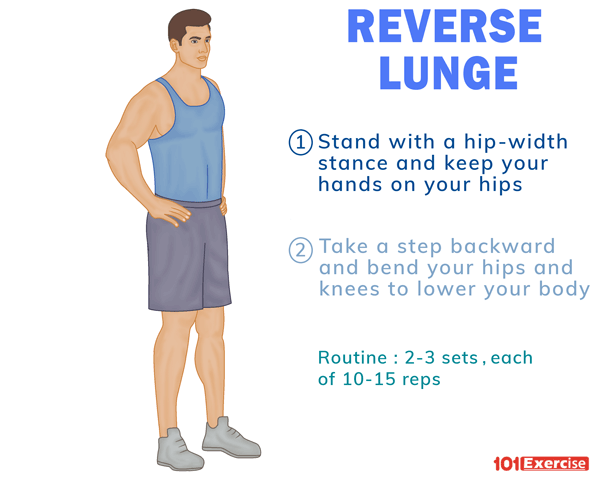Reverse Lunge
- Alternative Names: Step Back Lunge
- Type: Strength
- Experience Level: Beginner
- Equipment: None
- Muscles Targeted: Back, hips, thighs, legs
- Mechanics: Compound
- Average Number of Sets: 2-3 with 10-15 reps each
- Variations: Barbell, dumbbell, goblet, Smith machine, front rack, stepped-up, landmine, TRX, knee lift, prisoner reverse lunges
- Alternative: Reverse squat, dumbbell step-up
The reverse lunge, unlike the traditional forward lunge, is done by extending one of the legs backward. For doing this leg-strengthening exercise, you should have adequate ankle and hip mobility, without which flexing the foot can be difficult and you may get stuck at the ankle while doing the lunge.
Benefits
- Safer for your knees, as you are less likely to overstretch the leg and take your knee too far backward.
- Can be used as a warm-up exercise before any strenuous workout routine to stretch your hamstrings, glutes, and quads.
- Movement is done with less momentum, and thus easier to control.
Reverse vs Forward Lunge
- Reverse lunges allow you to maintain your body weight on the heels while the momentum of forward lunge shifts the weight to the ball of your foot.
- The movement during the reverse lunge lets you get deeper than the traditional lunge, helping you to maintain correct joint angles for optimum strength.
- With reverse lunges, the shin is kept more vertical than the forward version.
How to do a Reverse Lunge
Start the exercise by standing straight in a shoulder-width stance and the hands on your hips. Looking forward, take a step backward and lower your body by flexing your hips and knees. With your back leg making contact through the ball of the foot, move your hip downward until the knee almost touches the floor. After pausing for few seconds, go back to the initial position by pushing through the heel of your front leg.
Tips
- If you want to add this exercise to your workout routine, you should first try to improve your balance and stability by practicing 2-3 sets of split squat, each of 12-15 reps.
- Use a controlled motion while lowering the knee of your back leg. It should be aligned in line with the foot of your back leg.
- For gaining strength and power, do the exercise early in the leg routine. For adding muscle mass and building endurance, however, do it late in the workout routine.
Variations
- Barbell Reverse Lunge: A quad-building exercise done by placing a weighted bar across the upper back.
- Dumbbell Reverse Lunge: Performed in the same way as the traditional reverse lunge except that you hold two dumbbells by your sides.
- Goblet Reverse Lunge: Done by holding the head of a dumbbell or sides of the handle of a kettlebell with an overhand grip.
- Smith Machine Reverse Lunge: Performed by assuming a reverse lunge stance under the smith machine bar.
- Front Rack Reverse Lunge: The barbell is placed in a front rack position while your elbows are pointing forward.
- Step Up to Reverse Lunge: Involves stepping up on a bench and then assuming a reverse lunge position.
- Landmine Reverse Lunge: Performed by holding a barbell secured in a landmine attachment.
- TRX Reverse Lunge: Involves the standard reverse lunge movement while holding the TRX suspension bands.
- Reverse Lunge with Knee Lift: Done by lunging back one of the feet and then raising the knee forward.
- Reverse Prisoner Lunges: Comprises the traditional lunge with the hands positioned at the back of the head.
Alternative Exercises
- Reverse Squat
- Dumbbell Step-Up

